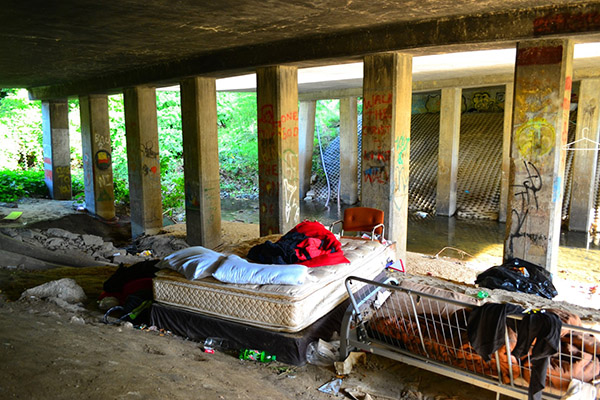Breadcrumb
Housing the homeless
By Debra Venzke
Published on January 8, 2016
A new initiative called Housing First seeks to break the costly cycle of chronic homelessness.
 It’s difficult to put a “typical” face to homelessness. Shelley battled with depression and had trouble finding steady work. John lost his job; soon after, his home was destroyed in a fire. Penny experienced domestic violence. Steve struggled with addiction. All became homeless. Today, each of these individuals has found housing and is involved with the “Faces of Homelessness” speakers’ bureau run by the National Coalition for the Homeless.
It’s difficult to put a “typical” face to homelessness. Shelley battled with depression and had trouble finding steady work. John lost his job; soon after, his home was destroyed in a fire. Penny experienced domestic violence. Steve struggled with addiction. All became homeless. Today, each of these individuals has found housing and is involved with the “Faces of Homelessness” speakers’ bureau run by the National Coalition for the Homeless.
The homeless population is made up of all ages, races, and education levels, families, single people, veterans, and individuals with and without disabilities and substance use issues. While the specific reasons for becoming homeless vary, a major factor nationally is lack of affordable housing.
It’s also difficult, for a variety of reasons, to produce an accurate count of the homeless. To obtain a national “snapshot,” the U.S. Department of Housing and Urban Development (HUD) collects one-night counts of homeless from communities each year in January. On any given night in January 2014, nationwide 578,424 people were homeless — meaning they were sleeping outside or in an emergency shelter or transitional housing program.
Homelessness in Iowa
In Iowa, 11,638 people were homeless during 2014, according to a report by the Institute for Community Alliances. In Johnson County, an estimated 1,000 people are homeless.
College of Public Health students Amy Hoehne and Kendra Kramer interned with the Johnson County Local Homeless Coordinating Board (JCLHCB), a collaborative team of more than 20 agencies, in summer 2015 to gain additional public health experience.
“I thought the internship would be interesting and eye-opening because I didn’t know a lot about homelessness,” says Hoehne, an MPH in epidemiology candidate from Elma, Iowa. “[As a university student,] I don’t see people who are living out on the streets and the things they have to go through every day and the services they’re accessing just to survive.”
“It opened my eyes to how broad homelessness really is and how much of a problem it is,’” adds Kramer, an MPH in community and behavioral health candidate from Solon, Iowa. “I really wasn’t aware of how prevalent it is in Iowa City.”
Chronic Homelessness
Most people are homeless temporarily — they may need anything from several weeks of emergency shelter to two years in a transitional housing program until they’re able to attain stable housing.
A much smaller segment of the homeless population — less than 15 percent — is chronically homeless, HUD estimates. HUD defines chronic homelessness as either long-term and/or repeated bouts of homelessness coupled with a physical or mental disability.
Because of their complex behavioral and social problems, the chronically homeless are often frequent users of high-cost services at public expense. In other words, they repeatedly cycle through the emergency room, shelter, jail, detoxification programs, and so on, often at great expense to the community without any lasting improvement.
Hoehne and Kramer helped to finalize a case study that the JCLHCB conducted of four individuals who were among the most chronically homeless individuals in Iowa City and frequent users of social, health, and criminal justice services. Hoehne worked on organizing and entering data for the study, while Kramer researched and wrote a report summarizing the case study findings as well as researching potential grant opportunities.
The case study results were revealing: on average, each of the four individuals in the study accumulated approximately $139,662 per person per year in un-reimbursed costs. Throughout the five years of the study, over $2.1 million in un-reimbursed costs were accrued. The majority of the costs (about 88 percent) were for medical/mental health services.
Housing First
To help break this cycle, many communities around the nation have implemented a model called Housing First, which places frequent users of social services into housing with no conditions — no drug tests, sobriety tests, or case-management is required. However, supportive services are readily available if clients desire them.
Evidence from such projects consistently shows that this model reduces costs to the community and improves quality of life for the participants.
“When you look at the data, you see that it is cost-beneficial to get these people housed and offer them services they need, so they’re not ending up in emergency rooms or jail,” says Hoehne.
In July 2015, Shelter House, an Iowa City-based homeless shelter and a member agency with the JCLHCB, was awarded a $15,000 grant from the Corporation for Supportive Housing to develop a Housing First project. The goal is to build housing for 12-15 eligible frequent users.
“The services that exist in our community, while efficacious for the majority of people experiencing homelessness, are not meeting the needs, nor are they being utilized cost effectively, for this cohort of individuals,” says Crissy Canganelli, executive director of Shelter House. “We can and must do better. We can either continue to watch people live and die on our streets, or work together to provide something new and different, adopting an approach that has been proven to be successful in other areas of our country. Housing First will help these individuals move beyond homelessness and live out their lives with improved health, dignity, and well-being.”
Learn more about the Housing First model at www.jchomeless.org.
Read more about how Jessica Larson (MHA/MPH ’14) organized a resource fair for homeless and low-income individuals as part of her practicum.
Photo by Anna Brett. This article originally appeared in the Fall 2015 issue of InSight